
Lead Service Line Inventory
BACKGROUND
In compliance with the Environmental Protection Agency’s (EPA) Lead and Copper Rule Revisions (LCRR) and Pennsylvania Department of Environmental Protection (DEP) requirements, the Municipal Authority of the Borough of Somerset (MABS) is conducting an inventory of all drinking water service lines in its system. As part of this inventory, MABS is working to identify the location and material of all drinking water service lines in its system by October 16, 2024. By inventorying all drinking water service lines in its system, MABS will be able to identify which of these service lines were installed using lead materials and then target those specific lead service lines for replacement. To limit disturbances to homeowners, MABS staff have been identifying the material of the service line as it enters a house when they are completing interior work, such as reading water meters, performing routine maintenance, or responding to service order calls.
What is a service line and who owns it?
A water service line is the small diameter pipe that connects the water main in the street to your home or building. Service lines can be made of copper, galvanized steel, iron, plastic, or lead. The owner of the property owns the water service line from the home to the curb stop. MABS owns the rest of the water service line (i.e., from the curb stop to the water main).
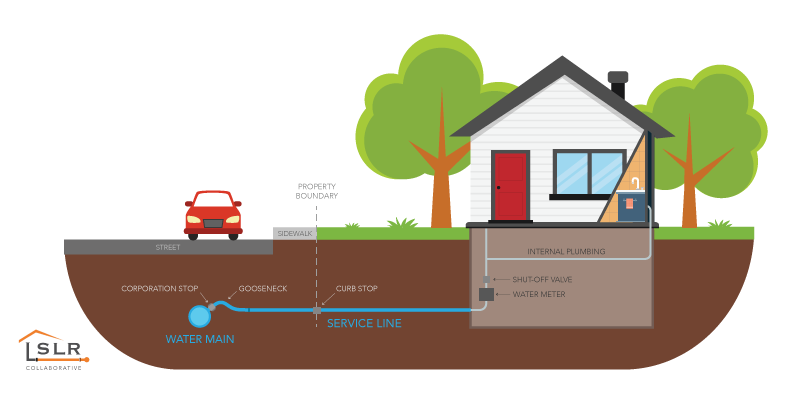
What does a service line look like?
The picture below shows the most common material types used for water service lines. Also, through our current waterline replacement project, we have begun to identify and replace existing lead service lines within the project’s scope. However, thousands are still unknown and we’re going to need your help to comply with this federal requirement. MABS has begun collecting customer/private side service line inventory, verifying the type of water service line coming from the water main in the street to your home as well as your internal plumbing material.
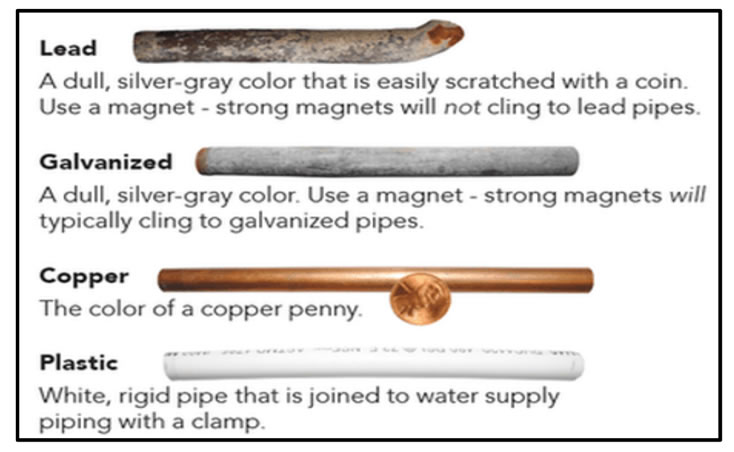
HELP US IDENTIFY SERVICE LINES
We need your help to access and look at your service line:
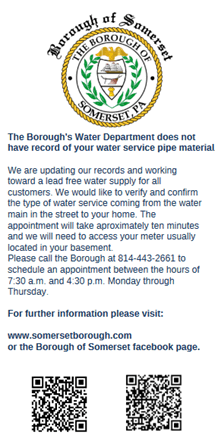 We have started sending out letters and personnel to gather information for our records and to comply with DEP requirements. Two of our employees are collecting the customer/private side water service line inventory (inside the home so we need your help to access and look at that line). They will be making their way around your neighborhood. These employees will have identification badges; additionally, you can call the Borough at (814) 443-2661 to confirm the name (s) of the employees.
We have started sending out letters and personnel to gather information for our records and to comply with DEP requirements. Two of our employees are collecting the customer/private side water service line inventory (inside the home so we need your help to access and look at that line). They will be making their way around your neighborhood. These employees will have identification badges; additionally, you can call the Borough at (814) 443-2661 to confirm the name (s) of the employees. - If our staff are unable to find you at home to conduct the interior water service line investigation, we will leave a door hanger behind (see example to the right) requesting that you call the Borough to schedule an appointment. Please contact us if you find one of these on your door, or at any time with questions.
- Our personnel may also have to verify the Authority/public side water service line at two locations along the service line outside your home, also known as ‘potholing’. Potholing uses hydro-excavation, high-pressure water and a vacuum, to remove soil without breaking manmade structures to create two 6-inch by 10-inch holes to look at service lines and determine what the material (s) are.
- In addition, you have the option to fill out the survey that is provided in the Customer Self-Identification/Notification GIS Map with information you collect. In this map you can view the progress and fill out the survey to assist with the customer-owned service line records.
Please keep in mind that we may still need to request verification by means of our employees coming into your home. Service lines may need to be exposed to verify the material, but MABS is working to minimize those circumstances.
Water Service Line Material Survey View ArcGIS Map here
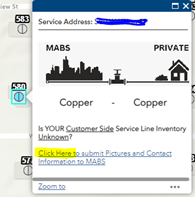 Once you navigate to the ArcGIS Online Map Viewer, locate your residence, and click on the circle icon. The box to the right will appear. Follow the steps to identify your service line material.
Once you navigate to the ArcGIS Online Map Viewer, locate your residence, and click on the circle icon. The box to the right will appear. Follow the steps to identify your service line material.
To complete this survey, you may need:
- A Smartphone or Tablet
- A Strong Magnet
- A Key
- A Lead Test Kit
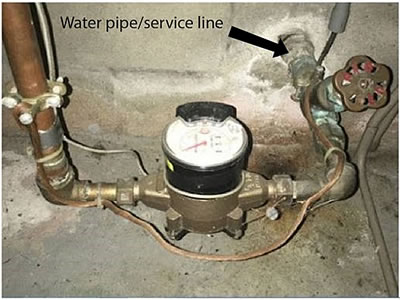 Locate Your Water Meter
Locate Your Water Meter
- Your water meter may be inside: in the basement, crawlspace, or garage.
- Typical outside locations are between the water main and your house, on the sidewalk, or in your yard.
- Locate Your Service Line
- If your meter is inside, the service line is near the meter, on the same wall.
- If your meter is outside, then the service line most likely enters the home closest the meter.
- If your service is not visible, contact your utility for guidance.
- Identify your service line material
- Plastic. The pipe is typically white or gray in colors. Although plastic does not contribute to lead in drinking water, lead may be present in other parts of the plumbing system.
- Metal pipes are copper, silver or gray. Conduct a scratch and magnet test on metal pipe by using a key or coin to gently scratch the pipe close to where it comes in through the wall or floor.
- Copper. The pipe is orange or pale orange.
- Galvanized steel. If the pipe is hard to scratch and a magnet sticks to the pipe, you may have galvanized steel pipes. Galvanized steel pipe can pose a risk if it has ever been connected to lead plumbing, as lead can attach to the inner surface of galvanized steel and be released into drinking water over time.
- Lead. If the pipe is soft, easy to scratch and a magnet does not stick to the pipe, your pipe is likely made of lead.
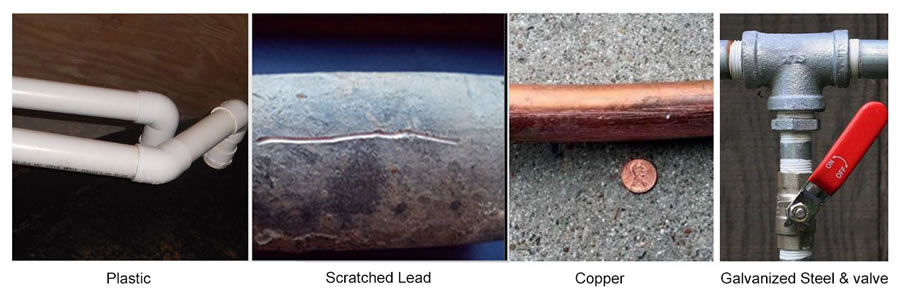
The Survey will ask for the following information in regards to the service line material:
- Install/Construction Date – if known
- Source of Information – (how you determined the material of the service line)
- Visual inspection
- Lead Test Kit
- Plumbing records
- Scratch test
- other
- Water service line material
- Photos
- Water service line as it enters the residence
- Scratch test photo if this was the verification method of service line material
- Water meter
- Customer backflow
Lead and Drinking Water
MABS conducts routine testing to ensure that our water meets all state and federal water quality requirements. Lead is not detected in MABS’s source of drinking water and there is no current concern at large in our system, but lead can enter drinking water when plumbing materials (i.e., pipes, faucets, fixtures) that contain lead corrode.
If present, elevated levels of lead can cause serious health problems, especially for pregnant women and young children. Young children, infants, and fetuses are particularly vulnerable to lead because the physical and behavioral effects of lead occur at lower exposure levels in children than in adults. A dose of lead that would have little effect on an adult can have a significant effect on a child. In children, low levels of exposure have been linked to damage to the central and peripheral nervous system, learning disabilities, shorter stature, impaired hearing, and impaired formation and function of blood cells.(1)
How do I reduce my lead exposure?
Regardless of whether you have a lead service line, you can take the following steps to protect yourself and your family from lead in tap water:
- Run your water from the cold faucet you use for drinking water before consuming it to flush out lead and copper for 15-30 seconds or until it becomes cold, especially after long periods of no use.
- Routinely clean faucet screens/aerators. Sediment and metals can collect in the faucet screen located at the tip of your faucets. Replace screens that are in poor condition.
-
Identify if your plumbing fixtures contain lead. When purchasing replacement plumbing products, make sure the products have been tested and certified to “lead-free” standards.
- If you use a home treatment device, make sure it is independently certified to reduce lead according to the NSF/ANSI-53 standard.
-
Always use cold water for drinking, cooking, and preparing baby formula. Boiling water will not remove lead or copper.
Frequently Asked Questions (FAQ)
The Municipal Authority of the Borough of Somerset (MABS) is undertaking an Initial Service Line investigation to determine the type of plumbing material utilized for the water service lines connected to its system. This initial investigation program is a requirement of both the EPA and the Pennsylvania DEP.
- Will there be a fee to the property owner for this service?
There is no fee for the Authority and/or its contractor to perform this investigation.
- What is involved in the potholing process?
The Authority will utilize a hydro‐excavator to excavate (6 inch by 10 inch hole) down to the point where your water service line is exposed. We are required to confirm the materials in two (2) locations along the exterior of your service line.
- Who will repair the grass or yard areas where the holes have been excavated?
Either the Authority or its contractor will make the yard repairs; this most likely will be done on a separate day from the investigation in order to repair multiple yards at a time.
- Do you need to enter my home for any reason?
Our investigation also requires us to look at the water service line where it first enters your house. We will provide each property owner with instructions on how to determine the material of that line. We may still request to enter your house. All Authority staff assigned to this work carry identification badges; additionally, you may call the office at 814‐443‐2661 to confirm the name of an employee or verify that they are scheduled to be at your house.
- Will I receive the results of the investigation for my property?
The Authority will provide you with the outcome of their investigation of your water service line, if requested. It can also be viewed on the Borough’s website by opening up the ArcGIS map viewer.
- Do I need to be home when you are doing the work in my yard?
You do not need to be home when the outdoor investigation occurs at your property.
- Why is The Municipal Authority of the Borough of Somerset doing this?
The Authority is following the schedule and requirements established by the PA DEP and the U.S. Environmental Protection Agency (EPA). The U.S. EPA’s Lead and Copper Rule Revision requires us to inventory all service lines by October 16, 2024.
Question about Public Notification Information
Will I receive/Why am I receiving a consumer notification?
The EPA’s Lead and Copper Rule Revisions require that any consumer served by a lead water service line, a galvanized water service line requiring replacement, or a water service line of unknown material be notified by November 15th, 2024. This notification contains important information about the health effects of lead, steps you can take to reduce exposure to lead in drinking water, and information about opportunities to verify the material of the service line/replacing your water service line.
Municipal Authority of the Borough of Somerset is required to provide annual notifications with this information to all consumers served by a lead water service line, a galvanized water service line requiring replacement, or a water service line of unknown material. If you replace your water service line or the material is determined to be non-lead, you will no longer receive an annual notification.
Why is my water service line classified as galvanized requiring replacement?
If your service line is a galvanized requiring replacement water service line, this means that some or all of the service line was, currently is, or could have been downstream of a lead source. For example, if your galvanized water service line was ever downstream of any portion of a lead water service line or lead gooseneck, pigtail, or connector (a small section of pipe that connects the service line to the water main), it is a potential source of lead exposure. Lead scale can build up on the interior of the galvanized piping and later release into your drinking water even after the original source of lead is replaced. If there are no records conclusively indicating the material upstream was never lead, a galvanized water service line must be classified as requiring replacement to be as protective of public health as possible.
Why is my water service line classified as unknown?
Public water systems must fully verify both sides (the private-side and public-side) of the water service line to classify its material. Municipal Authority of the Borough of Somerset staff may not have any records or sufficient evidence per federal and state requirements/guidelines to classify your service line material.
If the material of your water service line is unknown, Municipal Authority of the Borough of Somerset needs your help! Please contact as at 814-443-2661 to schedule an in-home inspection of your water service line, if you haven’t already done so. During an in-home inspection, Municipal Authority of the Borough of Somerset staff will visually inspect your water service line where it enters your home, typically in the basement or lowest level of the building. The in-home inspections take approximately 5-10 minutes. Also, let the Borough know if you have records of a service line replacement.
You can also follow the instructions at https://www.somersetborough.com/watersewer/lead_copper.htm to identify the material of your water service line and submit the information to Municipal Authority of the Borough of Somerset. Please be aware that Municipal Authority of the Borough of Somerset may still need to verify the information for service line inventory purposes per all federal and state requirements and guidelines. This will involve potholing and visually identifying the type of material at several other locations along the service line (public and private sides), if the Borough is not able to confirm with records. The Borough is still working out a schedule for this final verification step and will keep the website updated once more information is available.
Why is my water service line classified as unknown even though I let Municipal Authority of the Borough of Somerset inspect my service line or provided photos of service line?
Public water systems must fully verify both sides (the private-side and public-side) of the water service line to classify its material. If Municipal Authority of the Borough of Somerset staff already inspected your service line and/or you provided photos of your service line and the line is still unknown, Municipal Authority of the Borough of Somerset does not yet have sufficient evidence per federal and state requirements/guidelines to classify the service line material.
That federal requirements for public water systems to use “lead-free materials” first became effective in Pennsylvania on January 6, 1991. If you live in a home built after January 6, 1991, it is unlikely that you have lead materials in your service line or home plumbing. However, your property may still be categorized as a “water service line of unknown material” because Municipal Authority of the Borough of Somerset has not yet been able to fully verify both sides of the water service line.
Who is going to pay for my water service line replacement?
The property owner is responsible for maintaining and/or replacing the section of the water service line that they own, located from the home to the curb stop. Municipal Authority of the Borough of Somerset is available to help provide information on options for service line replacement to property owners. Municipal Authority of the Borough of Somerset is also exploring all financial options for water service line replacements and will update its website with new information about funding and other information resources as available.
I’m planning on replacing my water service line. Do I need to tell Municipal Authority of the Borough of Somerset?
Please notify Municipal Authority of the Borough of Somerset at 814-443-2661 if you are planning to replace the private-side water service line so we can coordinate a replacement of the public-side water service line as necessary. If you have already replaced the private-side water service line, please notify us as soon as possible so we can replace the public-side water service line as necessary.
Questions and/or Concerns
You may email your questions to: leadandcopper@somersetborough.com or call 814‐443‐2661.
Additional Resources
- Strategies to Reduce Lead Exposures and Disparities in US Communities (EPA)
- Lead and Copper Rule: Service Line Inventories (PA DEP)
- Lead in Drinking Water (PA DEP)
EPA’s Lead Service Line Replacement Accelerator Initiative
MABS has been selected to participate in EPA’s Lead Service Line Replacement Accelerator initiative, which provides direct technical assistance to water systems – at no cost to the water systems, to facilitate support in developing the required water service line inventory and planning for the removal of any lead water service lines identified. For more information about this initiative visit: https://www.epa.gov/water-infrastructure/lead-service-line-replacement-accelerators.